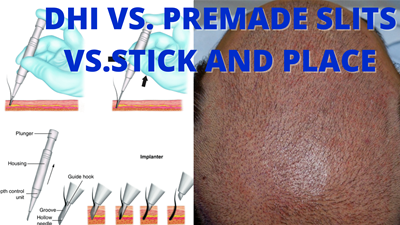There are only two methods for harvesting hair for hair transplant surgery. However, there are several methods to implant the hair follicles into the scalp. The traditional way is called pre-made slits. The newer method is called direct hair implantation (DHI). There are several variations between the two, stick and place, simultaneous extraction and placement. In this article, we will be going over the differences between each method.
Pre-Made Slits
Traditionally, hair transplant surgeons create pre-made slits where the hair follicle grafts will go. The slits are done before the grafts are harvested from the scalp. Once surgeons harvest the grafts, they place the grafts in a holding solution. The holding solution keeps the grafts from drying out and dying. This method has been around for decades. A surgeon can harvest and implant thousands of grafts using this method with excellent yield and growth. Per industry standards, it is normal for trained technicians to place the grafts into the pre-made slits using forceps.
Surgeons can control excessive bleeding by utilizing this method. Excessive bleeding can complicate the procedure and make it difficult for the surgeon to implant the grafts. Many surgeons feel pre-made slits have a significant advantage over the other methods for this reason.
Direct Hair Implantation (DHI)
DHI is a new method of implanting grafts into the recipient site. Unfortunately, this method has caused a massive amount of confusion. Many people confuse this technique as a harvesting method, comparing Follicular Unit Extraction (FUE) to DHI. FUE describes the method used to remove the hair from the back and sides of the scalp, and DHI implants the grafts into the top of the scalp. So, the most significant difference between DHI and other methods is that the surgeon simultaneously creates the recipient site and implants the graft simultaneously.
The main advantage of DHI is reducing the amount of time the grafts are outside of the body and speeding up the transplantation process. Unfortunately, there are a lot of clinics that promote this technique as fail-proof. That isn't true. Another factor to consider is who is implanting the grafts. The graft placement will determine the angle and density of the procedure. If an inexperienced technician places the grafts with the DHI method, it could be disastrous.
Stick and Place Method
The stick and place method can use traditional forceps or implanter pens. The surgeon immediately creates the recipient site and places the graft almost immediately. The difference between this method and DHI is that the recipient sites are done using blades instead of an implanter pen. Now, there are different types of implanter pens. Some implanter pens make sites and implant the grafts. Other implanter pens place the grafts in slits. Most surgeons who use the stick and place method place the grafts using forceps, similar to 'pre-made slits,' except the grafts are instantly placed.
The benefit of this method is that the grafts are not outside of the body for very long, and the surgeon can adjust the sites as they go through the procedure- this will help them place the grafts with optimal density. However, this method is reasonably advanced. Most surgeons who prefer this method are very experienced.
Conclusion
Methods and techniques are only as good as the individuals using them. When you're researching hair transplant surgery and surgeons, do not get hung up on the methods. Instead, look at the results and the experience of the surgeon/clinic. If you want to consult with world-renowned hair transplant surgeons, click here. Use lists and names as starting points for research. Understanding the pros and cons of each technique can be helpful, but no method will guarantee results.

